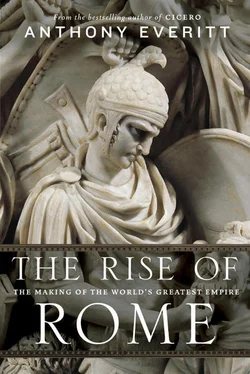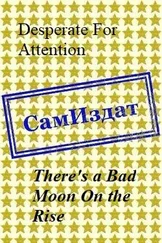This glittering world on its doorstep was strongly attractive to provincial Rome at the very time that its villages were coalescing into a city. The notion that Rome was occupied by the Etruscans is unsubstantiated, but their influence was profound. They set an example in religious observance, agricultural improvement, large drainage works, metalwork, and the construction of public buildings. In Latium, the new cities of Etruria were an encouragement for villagers to join forces and create larger settlements. By the time of the expulsion of the Tarquins, in 509, the original fifty or so small communities had been transmuted into ten or twelve substantial towns. These dominated the region, and the most populous—Praeneste (today’s Palestrina), Tibur (Tivoli), and Tusculum (today a ruin)—dealt with Rome on equal terms.
Economic growth brought with it social stratification—or, in plain terms, a class system. An aristocracy emerged in Latium, and princely chamber tombs have been excavated that contained jewelry and treasure—armor and chariots, brass cauldrons and tripods, gold and silver vessels, pottery from Corinth, and Phoenician amphorae.
The magicians who brought about these extraordinary transformations both in Etruria (as already noted) and, more slowly, in Latium were the Greeks. Their traders introduced the idea of the alphabet (so, too, we may suppose, did the Phoenicians), advanced technology, art and architecture, the Olympian gods and goddesses, myths and legends—including, of course, the story of Troy. Homer probably wrote his great epics, the Iliad and the Odyssey , a little earlier in the eighth century. They celebrate the virtues of aristocracy. Men such as Achilles had a pronounced sense of personal honor; in their eyes, they fought wars or engaged in politics in order to win glory, an imperishable name that was the nearest thing to immortality to which human beings could aspire. They were inordinately proud of their family trees (often fictional), and of their generous hospitality to strangers. They held that blood and bravery were qualities more desirable than the pursuit of wealth.
All of this the Romans digested and made their own. The patricians were Homeric in their pride and ambition for glory, in their hereditary claim to power in the state, and in their scorn for anything resembling a democratic form of government. In later ages, traditionalists liked to claim that Rome developed separately and only in its maturity discovered Hellenic civilization. Cicero has one of the speakers in his dialogue, The Republic , say, “We Romans got our culture, not from arts imported from overseas, but from the native excellence of our own people.” That could not be more wrong. Greece was in the room at the birth of Rome, and was in truth her midwife.
WE MAY SMILE at the legendary adventures of Romulus and Remus, but when classical authors imagined the site of Rome at its earliest beginnings they did not go far wrong. They pictured wooded hills and ravines, occupied by different villages, whose inhabitants were herdsmen and shepherds, although it was not long before they also included farmers. Virgil wrote in his national epic, the Aeneid , that the inhabitants
had no settled
Way of life, no civilization: ploughing, the formation of
Communal reserves, and economy were unknown then.
They lived on the produce of trees and the hard-won fare of the hunter.
They were an “intractable folk.” The Capitol, “golden today, [was] then a tangle of thicket.… Cattle were everywhere, lowing in what is now the Forum of Rome.”
As already mentioned, the Romans believed that Romulus’s fortified town was built on the Palatine and regarded the Casa Romuli, Romulus’s house, on the western side of the hill, as a monument to those primal times. An assemblage of wattle and daub with a thatched roof, it survived for many centuries and often had to be repaired, either because it burned down, thanks to careless priests with their sacrificial fires, or to redress the ravages of weather and time.
It is here that the foundations of a village have been excavated. At the lowest strata, contemporary with the first huts, hearths have been found with pottery of a kind common in the eighth century—a happy coincidence with Varro’s date for Rome’s foundation, 753. There have been other suggestive finds—graves, for example, that contained pottery and bronze implements very similar to those of contemporary cultures south of Rome among the Alban Hills. Also, graves in the marshy land that was to become the Roman Forum are of two types: ditches ( fossae ), in which the bodies of the dead were buried in coffins; and pits ( pozzi ), in which after cremation their ashes were placed in urns. This tends to confirm the tradition that different groups with different customs occupied different hills.
However, as we have seen, Varro was too early. Evidence from under the ground has confirmed that a hundred years had to pass before the villages among the seven hills were amalgamated into a single settlement. It is only now, in the mid to late 600s, that Rome comes into being as an urban community and, in all probability, a monarchy was established.
How do we know this? In the marshy valley beneath the Palatine and the Capitol, there used to be a marketplace, doubtless consisting of little more than a few tables or carts. In about the middle of the seventh century, some huts were demolished, infill was imported to level the ground, and a rough, beaten floor was laid—the first public square, or Forum. Later, the pavement was extended to take in the Comitium, an open-air space for the holding of Assemblies. In its earliest phase, the Cloaca Maxima , or Great Drain, helped to dry out the land and make it usable for public meetings, shops, and temples. A building dating from about 600 has been identified as the Senate House.
At one end of the Forum, a small triangular edifice survives to the present day. Once larger than it is now, the structure was built on a site previously occupied by a group of ten or twelve huts, which were demolished to make way for it. This was Numa’s Regia, and its name suggests that this was the king’s official residence.
The foundations of a vast, archaic temple can still be seen on the Capitol. This was the Tarquins’ Temple of Jupiter Best and Greatest. It testifies to the magnificence of the Rome they governed.
The eagle that stole Priscus’s hat at the Janiculum saw across the river a patchwork of huts on the tops of wooded slopes. If the bird were to survive a normal span of thirty years and once again fly over the cluster of hills by the Tiber, it would be startled by the spectacle below—a busy market square, bright colored shrines and temples, shops and public buildings. A shiny, brand-new city.
6

Free at Last
HAVING DISPOSED OF THE TARQUINS, BRUTUS AND his fellow conspirators had to decide what to do next. In principle, each of them could very well have presented himself to the People as a successor king. That they did not do so, but instead established a republic, is a sign that this was not a revolt from “below” but a plot by resentful aristocrats, who wanted government by the élite.
We have already noticed that the last three kings were not patricians but outsiders, even foreigners; their power flowed from the People. According to the literary record, Superbus bullied the nobles mercilessly, and it looks very much as if they now took their revenge. That members of his family, Brutus and Collatinus, Lucretia’s husband, headed the coup, shows that even his core support broke with him—quite possibly because of a sex scandal rather than because of political disagreement. The Lucretia story reads rather like the plot of a stage play, but, as we have surmised, there may have been more than a germ of truth in it.
Читать дальше









